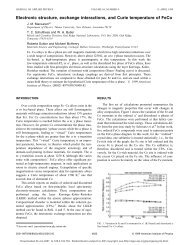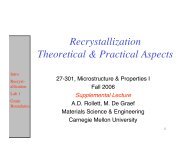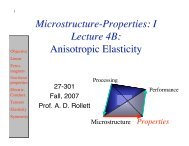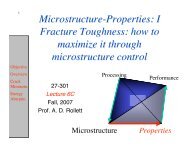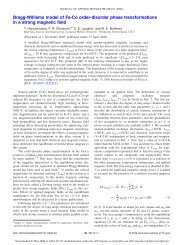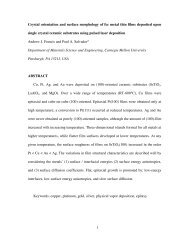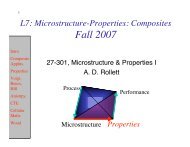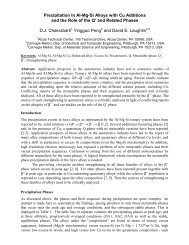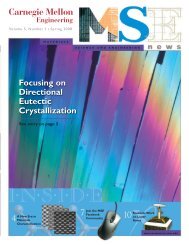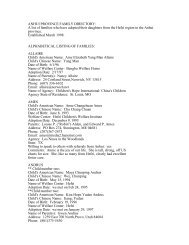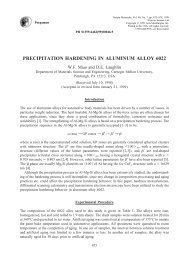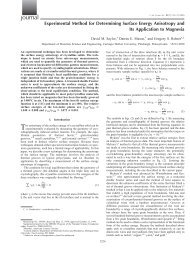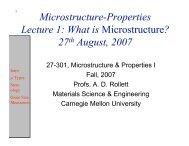popLA Manual (PDF) - Materials Science and Engineering
popLA Manual (PDF) - Materials Science and Engineering
popLA Manual (PDF) - Materials Science and Engineering
You also want an ePaper? Increase the reach of your titles
YUMPU automatically turns print PDFs into web optimized ePapers that Google loves.
HARMONIC ANALYSIS (page 4)<br />
HARMONIC ANALYSIS (<strong>popLA</strong> page 4)<br />
0. Quit<br />
1. Return to Page 1<br />
Find harmonic coefficients .HCF, completed PFs (.FUL) for:<br />
2. Cubic crystal system<br />
3. Hexagonal, tetragonal or orthorhombic crystal system<br />
4. Compute SOD or COD from harmonic coefficients (slow!)<br />
5. Recalculate pole figures .HPF<br />
6. Inverse pole figures .HIP<br />
7. List harmonic coefficients to screen or printer<br />
8. Establish coefficients for a given transformation<br />
9. Apply TRANSFORMATION to given coefficients<br />
Note: To convert Aachen-format Bunge coeffs. to Kallend’s binary<br />
Roe coeff.file .HCF: use AC2Wlmn (outside this menu) -<br />
Also need FAKTOR.CtW (J. Hirsch)<br />
Please enter a number from 0 to 7 --><br />
#0 Quit<br />
Selecting this option quits <strong>popLA</strong> <strong>and</strong> returns control to DOS comm<strong>and</strong> shell<br />
#1 Return to Page 1<br />
Selecting this option returns control to the main menu of <strong>popLA</strong><br />
#2 Harmonic Analysis—Cubic<br />
mn<br />
Determines the harmonic coefficients Wl from a sample with cubic symmetry--even l only, to l=22. When<br />
this option is selected, <strong>popLA</strong> displays<br />
Pole figure analysis to fit Wlmn, cubic<br />
Harmonic method<br />
Program (c) John Kallend 1971, 1982<br />
(x) Pole Figures read in<br />
How many iterations on missing parts? 6<br />
Six or eight iterations is usually sufficient.<br />
Sample Symmetry<br />
0. Orthorhombic<br />
1. Mirror perpendicular to Z<br />
Enter 0 or 1 ==> 0<br />
After sample symmetry is entered, <strong>popLA</strong> determines the harmonic coefficients from the data. After the<br />
calculation is completed it will ask if you would like to print the harmonic coefficients to the screen. The output<br />
of this program is an .HCF file which contains the harmonic coefficients (in a binary format) <strong>and</strong> a .FUL file,<br />
which is a pole figure which has been extrapolated to low (non-measurable) angles using the harmonic<br />
coefficients determined during the analysis. Note that the .HCF file is not a density file like most of the files (i.e.<br />
pole figures) produced by <strong>popLA</strong>.<br />
#3 Harmonic Analysis—Lower Symmetry<br />
mn<br />
Determines the harmonic coefficients Wl (for l even, to 22) from a sample with orthorhombic, tetragonal, or<br />
hexagonal symmetry. It is necessary to know information about the unit cell because the sample is not cubic.<br />
The requests for input are self-explanatory.<br />
Pole figure analysis to fit Wlmn, non cubic<br />
Harmonic method<br />
Program (c) John Kallend 1971, 1982<br />
(x) Pole Figures read in<br />
How many iterations on missing parts? 6<br />
Six or eight iterations is usually sufficient.<br />
ODF Analysis for (file)<br />
Enter CRYSTAL SYSTEM code<br />
2=ORTHORHOMBIC, 4=TETRAGONAL, 6=HEXAGONAL<br />
Enter 2, 4, or 6 ===> 2<br />
(Program requests information about ratio of sides in the unit cell)<br />
Please enter sample symmetry:<br />
DETAILS 28



